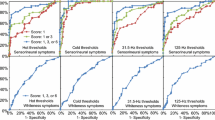Abstract.
Objectives: To assist occupational health professionals to interpret the results of standardised tests for components of the hand-arm vibration syndrome by presenting data for healthy subjects and identifying the effects of some of the confounding variables. Method: Thermal thresholds, vibrotactile thresholds, the finger skin temperature (FST) response to cold provocation and percentage finger systolic blood pressures (%FSBP) were measured by standardised procedures. Normative data were obtained for healthy men of working age (17–62 years) during 237 experimental sessions encompassing ten different studies. Hot thermal thresholds and cold thermal thresholds were assessed independently with 38 subjects; 152 measurements of both hot and cold thresholds were made. Vibrotactile thresholds were measured at several locations on 81 subjects, giving a total of 216 measurements at 125 Hz and at 31.5 Hz. The FST response to cold provocation at 15 °C was monitored by thermocouples throughout a 2-min settling period, a 5-min immersion period and a 10-min recovery period. A total of 302 measurements was made on 70 subjects. The %FSBPs were measured in four test fingers and one reference finger by strain-gauge plethysmography. Measurements were made on 97 subjects. A total of 351 measurements was made at 15 °C, with 341 measurements at 10 °C. Results: Normative data and some example normal limits are presented from the current data set and from data presented in other studies. Age was found to influence thermal thresholds, vibrotactile thresholds and the FST response to cold provocation; older subjects exhibited deteriorated vascular and neurological function. Room temperature was found to influence %FSBPs and the FST response to cold provocation; warmer environments resulted in improved vascular response to cold. Outdoor temperature had a small effect on the FST response to cold provocation and on the vibrotactile thresholds. Thermal thresholds showed some influence of smoking habits and of the FST measured prior to testing. For all four tests, any differences between measurement locations were small and there were no differences between left-handed and right-handed subjects. Conclusions: The current data can assist occupational health professionals to interpret the results of the standardised tests. Comparison with the current data is considered valid for men of working age. Age and room temperature should be recognised as being capable of causing changes in neurological and vascular function.
Similar content being viewed by others
Author information
Authors and Affiliations
Additional information
Electronic Publication
Rights and permissions
About this article
Cite this article
Lindsell, C.J., Griffin, M.J. Normative data for vascular and neurological tests of the hand-arm vibration syndrome. IAOEH 75, 43–54 (2002). https://doi.org/10.1007/s004200100277
Received:
Accepted:
Issue Date:
DOI: https://doi.org/10.1007/s004200100277



